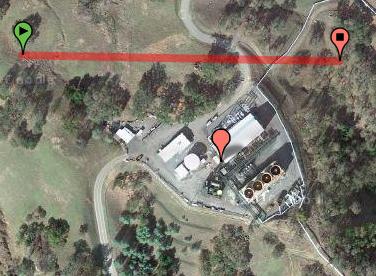
Vane Lashua | thnktnk.net/drill.html
In the early 20th century Thomas Edison described our present situation:
We are like tenant farmers chopping down the fence around our house for fuel when we should be using Nature's inexhaustible sources of energy — sun, wind and tide.... What a source of power! I hope we don't have to wait until oil and coal run out before we tackle that. —Wikiquote
Meanwhile, one source of perpetual energy slipped Edison's mind ... and it's within ten miles of everywhere on earth: straight down! Besides providing a true opportunity for "energy independence", refining current technology to tap and deliver it also promises a huge opportunity to challenge America's best scientific, engineering and technical talent and to provide thousands of jobs. New New Deal? You betcha!

Some alternative energy conversations include residential geothermal energy. Starting about six feet down, the temperature is at least 54°F. Put pipes in the ground, circulate a refridgerant through a heat pump and voilà: efficient, money-saving heating and cooling! Need more capacity? Drill wells, circulate lots of water, and you have the configuration at right. 
Geothermal power generation is most often considered where there are geysers and hot springs near the earth's surface—in Iceland, New Zealand and The Geysers in California, for instance. Hot water and steam are used directly to heat buildings and steam is used to drive turbines to generate electricity.
Deep geothermal or Engineered Geothermal Systems (EGS) is an extension of that technology. The deeper one goes below the surface of the earth, the hotter it gets. Within 10 miles down—everywhere on earth!—the temperature reaches 1000°F. A typical plant can supply more than enough electricity on site for practically any airport or military base—and its surrounding communities.
Moderately sized EGS plants can provide power for over 100,000 homes, feed the existing electrical power grid and be sited near virtually any city in the US. Much safer, cleaner and less costly than nuclear, oil or coal-fired plants, deep geothermal plants use only the earth's heat, in place, rather than burning fossil fuels. There are NO waste by-products. None! With geothermal, there are no concommitant mining, drilling, refining and fuel transport and storage costs as required by fossil fuels. It is even feasible to decommission and re-purpose an existing coal, gas, oil or nuclear power plant's generation equipment — in place — and supply it with heat from deep geothermal wells!
 The geothermal plant pictured here [Aidlin Calpine 1] occupies less than 20 acres [8 hectares] and generates 10-17MW of power. The red line on the picture represents 1200 feet [366 meters]. In the type of installation described by one patent generating gear could even be located below ground, to eliminate noise reduce potential surface environmental impacts.
The geothermal plant pictured here [Aidlin Calpine 1] occupies less than 20 acres [8 hectares] and generates 10-17MW of power. The red line on the picture represents 1200 feet [366 meters]. In the type of installation described by one patent generating gear could even be located below ground, to eliminate noise reduce potential surface environmental impacts.
As was the case with the construction of the Hoover Dam during the '30s, the technology involved is conventional. In some areas, the limits of conventional thinking and engineering may have to be stretched to drill to depths beyond six or seven miles. Meanwhile, name an engineering school or research lab that wouldn't love the challenge! MIT produced a report in 2006 for the USGS that discusses the costs and benefits in detail.
Major "energy" companies like Chevron and BP have all the resources they need to move away from commodities trading in oil or gas to drilling for heat and supplying electricity in place. Even drillers doing the evil "fracking" today could use their equipment and skills to drill for heat and create non-polluting wells of energy.
The Defense Department has proposed huge solar farms on military bases. The area required for one solar farm (a square mile of panels) could instead host 16 geothermal plants producing three times the energy at about a fourth the cost — and not just during the day! For less than the cost of an equivalent solar farm or one F-35 fighter, we could put a deep geothermal plant on practically any military installation in the US, save taxpayers $billions, make the bases more secure, become completely energy independent AND free up precious oil for use as fuel, lubricants or for the production of plastics.
An added benefit ... as realized in Santa Rosa, CA ... is that wastewater from sewers and storm runoff is used for "input" to the geothermal process. First, solids are removed (conventionally) from the wastewater and composted with derivative heat to generate methane gas. At the geothermal plant, the "gray-water" is cycled to the deep aquafer where it is naturally boiled back to steam.
Ultimately clean water is returned to the local aquafer or as steam piped to heat local buildings — just as many power plants do today. The Department of Energy is looking for just such funding opportunities! The administration could use it as part of a "new New Deal". For instance, The whole of Long Island could be supplied from several plants located discretely between east- and westbound lanes of the Long Island Expressway.
The Geothermal Energy Association's Geothermal Basics page is a comprehensive survey of geothermal progress, research opportunities, energy resources and development potential. The GEA tends to favor solutions already in place, but there are many links to comprehensive resources.
There is no single alternative energy magic bullet. Conservation, residential, commercial and district geothermal, solar thermal, solar electric, wind and hydro stand out as priorities for localities.
Practically anywhere on earth, deep geothermal/EGS is the clear strategic winner over nuclear, coal, oil, gas, garbage, biofuel and, surprisingly, large-scale wind and solar thermoelectricity for grid-connected, high output production of GHG-free electricity.
Praise Geo! ... Drill, Baby, Drill!
Link print reference